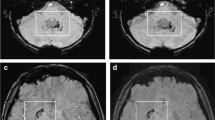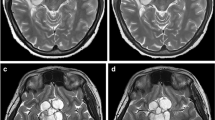Abstract
Background
Fast magnetic resonance imaging (MRI) sequences are advantageous in pediatric imaging as they can lessen child discomfort, decrease motion artifact and improve scanner availability.
Objective
To evaluate the feasibility of an ultrafast wave-CAIPI (controlled aliasing in parallel imaging) MP-RAGE (magnetization-prepared rapid gradient echo) sequence for brain imaging of awake pediatric patients.
Materials and methods
Each MRI included a standard MP-RAGE sequence and an ultrafast wave-MP-RAGE sequence. Two neuroradiologists evaluated both sequences in terms of artifacts, noise, anatomical contrast and pathological contrast. A predefined 5-point scale was used by two independent pediatric neuroradiologists. A Wilcoxon signed-rank test was used to evaluate the difference between sequences for each variable.
Results
Twenty-four patients (14 males; mean age: 11.5±4.5 years, range: 1 month to 17.8 years) were included. Wave-CAIPI MP-RAGE provided a 77% reduction in scan time using a 32-channel coil and a 70% reduction using a 20-channel coil. Visualization of the pathology, artifacts and pathological enhancement (including parenchymal, leptomeningeal and dural enhancement) was not significantly different between standard MP-RAGE and wave-CAIPI MP-RAGE (all P>0.05). For central (P<0.001) and peripheral (P<0.001) noise, and the evaluation of the anatomical structures (P<0.001), the observers favored standard MP-RAGE over wave-CAIPI MP-RAGE.
Conclusion
Ultrafast brain imaging with wave-CAIPI MP-RAGE is feasible in awake pediatric patients, providing a substantial reduction in scan time at a cost of subjectively increased image noise.





Similar content being viewed by others
References
Sasaki M, Inoue T, Tohyama K et al (2003) High-field MRI of the central nervous system: current approaches to clinical and microscopic imaging. Magn Reson Med Sci 2:133–139
Fushimi Y, Miki Y, Urayama S-I et al (2007) Gray matter-white matter contrast on spin-echo T1-weighted images at 3 T and 1.5 T: a quantitative comparison study. Eur Radiol 17:2921–2925
Mugler JP 3rd, Brookeman JR (1990) Three-dimensional magnetization-prepared rapid gradient- echo imaging (3D MP RAGE). Magn Reson Med 15:152–157
Sodickson DK, Manning WJ (1997) Simultaneous acquisition of spatial harmonics (SMASH): fast imaging with radiofrequency coil arrays. Magn Reson Med 38:591–603
Pruessmann KP, Weiger M, Scheidegger MB, Boesiger P (1999) SENSE: sensitivity encoding for fast MRI. Magn Reson Med 42:952–962
Griswold MA, Jakob PM, Heidemann RM et al (2002) Generalized autocalibrating partially parallel acquisitions (GRAPPA). Magn Reson Med 47:1202–1210
Wharton S, Bowtell R (2012) Fiber orientation-dependent white matter contrast in gradient echo MRI. Proc Natl Acad Sci U S A 109:18559–18564
Haacke E, Tang J, Neelavalli J, Cheng YCN (2010) Susceptibility mapping as a means to visualize veins and quantify oxygen saturation. J Magn Reson Imaging 32:663–676
Bilgic B, Gagoski BA, Cauley SF et al (2015) Wave-CAIPI for highly accelerated 3D imaging. Magn Reson Med 73:2152–2162
Setsompop K, Feinberg DA, Polimeni JR (2016) Rapid brain MRI acquisition techniques at ultra-high fields. NMR Biomed 29:1198–1221
Polak D, Setsompop K, Cauley SF et al (2018) Wave-CAIPI for highly accelerated MP-RAGE imaging. Magn Reson Med 79:401–406
Guérin B, Stockmann JP, Baboli M et al (2016) Robust time-shifted spoke pulse design in the presence of large B0 variations with simultaneous reduction of through-plane dephasing, B1+ effects, and the specific absorption rate using parallel transmission. Magn Reson Med 76:540–554
Goncalves Filho ALM, Conklin J, Longo MGF et al (2020) Accelerated post-contrast wave-CAIPI T1 SPACE achieves equivalent diagnostic performance compared with standard T1 SPACE for the detection of brain metastases in clinical 3T MRI. Front Neurol 11:587327
Dietrich O, Raya JG, Reeder SB et al (2007) Measurement of signal-to-noise ratios in MR images: influence of multichannel coils, parallel imaging, and reconstruction filters. J Magn Reson Imaging 26:375–385
Danieli L, Riccitelli GC, Distefano D et al (2019) Brain tumor-enhancement visualization and morphometric assessment: a comparison of MPRAGE, SPACE, and VIBE MRI techniques. AJNR Am J Neuroradiol 40:1140–1148
Afacan O, Erem B, Roby DP et al (2016) Evaluation of motion and its effect on brain magnetic resonance image quality in children. Pediatr Radiol 46:1728–1735
Bjur KA, Payne ET, Nemergut ME et al (2017) Anesthetic-related neurotoxicity and neuroimaging in children: a call for conversation. J Child Neurol 32:594–602
Kamat PP, Kudchadkar SR, Simon HK (2019) Sedative and anesthetic neurotoxicity in infants and young children: not just an operating room concern. J Pediatr 204:285–290
Schmid W, Marhofer P, Opfermann P et al (2020) Brainwave entrainment to minimise sedative drug doses in paediatric surgery: a randomised controlled trial. Br J Anaesth 125:330–335
Polak D, Cauley S, Huang SY et al (2019) Highly-accelerated volumetric brain examination using optimized wave-CAIPI encoding. J Magn Reson Imaging 50:961–974
Kozak BM, Jaimes C, Kirsch J, Gee MS (2020) MRI techniques to decrease imaging times in children. Radiographics 40:485–502
Woodfield J, Kealey S (2015) Magnetic resonance imaging acquisition techniques intended to decrease movement artefact in paediatric brain imaging: a systematic review. Pediatr Radiol 45:1271–1281
Jaimes C, Gee MS (2016) Strategies to minimize sedation in pediatric body magnetic resonance imaging. Pediatr Radiol 46:916–927
Eun D-I, Jang R, Ha WS et al (2020) Deep-learning-based image quality enhancement of compressed sensing magnetic resonance imaging of vessel wall: comparison of self-supervised and unsupervised approaches. Sci Rep 10:13950
Acknowledgments
Authors Azadeh Tabari and John Conklin contributed equally.
Author information
Authors and Affiliations
Corresponding author
Ethics declarations
Conflicts of interest
None
Additional information
Publisher’s note
Springer Nature remains neutral with regard to jurisdictional claims in published maps and institutional affiliations.
Rights and permissions
About this article
Cite this article
Tabari, A., Conklin, J., Figueiro Longo, M.G. et al. Comparison of ultrafast wave-controlled aliasing in parallel imaging (CAIPI) magnetization-prepared rapid acquisition gradient echo (MP-RAGE) and standard MP-RAGE in non-sedated children: initial clinical experience. Pediatr Radiol 51, 2009–2017 (2021). https://doi.org/10.1007/s00247-021-05117-5
Received:
Revised:
Accepted:
Published:
Issue Date:
DOI: https://doi.org/10.1007/s00247-021-05117-5




